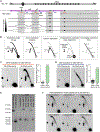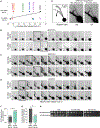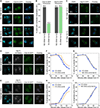Ribosomal DNA replication time coordinates completion of genome replication and anaphase in yeast
- PMID: 36842087
- PMCID: PMC10142053
- DOI: 10.1016/j.celrep.2023.112161
Ribosomal DNA replication time coordinates completion of genome replication and anaphase in yeast
Abstract
Timely completion of genome replication is a prerequisite for mitosis, genome integrity, and cell survival. A challenge to this timely completion comes from the need to replicate the hundreds of untranscribed copies of rDNA that organisms maintain in addition to the copies required for ribosome biogenesis. Replication of these rDNA arrays is relegated to late S phase despite their large size, repetitive nature, and essentiality. Here, we show that, in Saccharomyces cerevisiae, reducing the number of rDNA repeats leads to early rDNA replication, which results in delaying replication elsewhere in the genome. Moreover, cells with early-replicating rDNA arrays and delayed genome-wide replication aberrantly release the mitotic phosphatase Cdc14 from the nucleolus and enter anaphase prematurely. We propose that rDNA copy number determines the replication time of the rDNA locus and that the release of Cdc14 upon completion of rDNA replication is a signal for cell cycle progression.
Keywords: CP: Molecular biology; Cdc14; Fob1; anaphase; cell cycle; copy number variation; nucleolus; origin of replication; rDNA; replication timing; ribosomal DNA.
Copyright © 2023 The Authors. Published by Elsevier Inc. All rights reserved.
Conflict of interest statement
Declaration of interests C.Q. is a Cell Reports Advisory Board member, Ecology and Evolution.
Figures







Similar articles
-
Putting the brake on FEAR: Tof2 promotes the biphasic release of Cdc14 phosphatase during mitotic exit.Mol Biol Cell. 2009 Jan;20(1):245-55. doi: 10.1091/mbc.e08-08-0879. Epub 2008 Oct 15. Mol Biol Cell. 2009. PMID: 18923139 Free PMC article.
-
Cdc14p/FEAR pathway controls segregation of nucleolus in S. cerevisiae by facilitating condensin targeting to rDNA chromatin in anaphase.Cell Cycle. 2004 Jul;3(7):960-7. doi: 10.4161/cc.3.7.1003. Epub 2004 Jul 4. Cell Cycle. 2004. PMID: 15190202 Free PMC article.
-
Essential global role of CDC14 in DNA synthesis revealed by chromosome underreplication unrecognized by checkpoints in cdc14 mutants.Proc Natl Acad Sci U S A. 2009 Aug 25;106(34):14466-71. doi: 10.1073/pnas.0900190106. Epub 2009 Aug 7. Proc Natl Acad Sci U S A. 2009. PMID: 19666479 Free PMC article.
-
The Multiple Roles of the Cdc14 Phosphatase in Cell Cycle Control.Int J Mol Sci. 2020 Jan 21;21(3):709. doi: 10.3390/ijms21030709. Int J Mol Sci. 2020. PMID: 31973188 Free PMC article. Review.
-
Cdc14 phosphatase: warning, no delay allowed for chromosome segregation!Curr Genet. 2016 Feb;62(1):7-13. doi: 10.1007/s00294-015-0502-1. Epub 2015 Jun 27. Curr Genet. 2016. PMID: 26116076 Free PMC article. Review.
Cited by
-
Sir2 and Fun30 regulate ribosomal DNA replication timing via MCM helicase positioning and nucleosome occupancy.bioRxiv [Preprint]. 2024 Oct 28:2024.03.21.586113. doi: 10.1101/2024.03.21.586113. bioRxiv. 2024. Update in: Elife. 2025 Jan 20;13:RP97438. doi: 10.7554/eLife.97438. PMID: 38585982 Free PMC article. Updated. Preprint.
-
Sir2 and Fun30 regulate ribosomal DNA replication timing via MCM helicase positioning and nucleosome occupancy.Elife. 2025 Jan 20;13:RP97438. doi: 10.7554/eLife.97438. Elife. 2025. PMID: 39831552 Free PMC article.
-
SIRT1 Prevents R-Loops during Chronological Aging by Modulating DNA Replication at rDNA Loci.Cells. 2023 Nov 15;12(22):2630. doi: 10.3390/cells12222630. Cells. 2023. PMID: 37998365 Free PMC article.
-
Origin and maintenance of large ribosomal RNA gene repeat size in mammals.Genetics. 2024 Sep 4;228(1):iyae121. doi: 10.1093/genetics/iyae121. Genetics. 2024. PMID: 39044674 Free PMC article.
-
Phenotypic tolerance for rDNA copy number variation within the natural range of C. elegans.PLoS Genet. 2025 Jul 2;21(7):e1011759. doi: 10.1371/journal.pgen.1011759. eCollection 2025 Jul. PLoS Genet. 2025. PMID: 40601579 Free PMC article.
References
Publication types
MeSH terms
Substances
Grants and funding
LinkOut - more resources
Full Text Sources
Molecular Biology Databases
Miscellaneous

